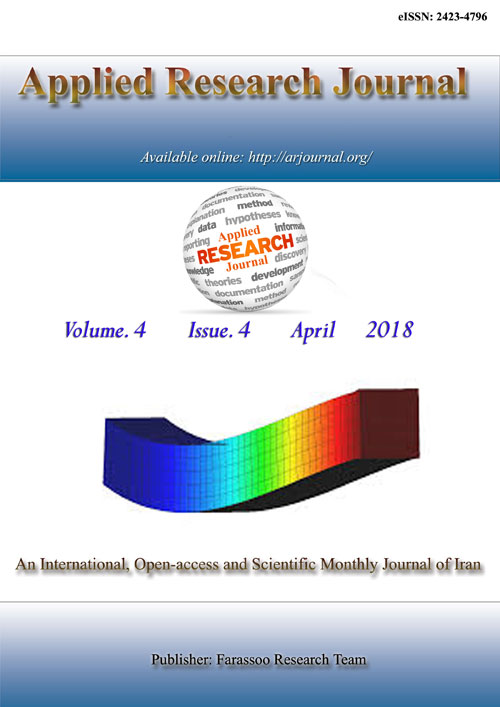فهرست مطالب
Applied Research Journal
Volume:3 Issue: 2, Feb 2017
- تاریخ انتشار: 1396/01/18
- تعداد عناوین: 5
-
Pages 47-52The subgrade soil always suffers from variation in the level of moisture due to many factors such as capillary action, precipitation, flood, and change in groundwater table. So, it''s very important for the engineer to understand clearly the nature of relationship between the subgrade strength and variation in moisture. The main objective of this study is to investigate the changing in the strength and durability of subgrade soil due to the variation in water content. The natural samples tested with three percentages of moisture contents (11.5%, 13.5%, and 15.5%).Physical and chemical tests are carried out on the natural soil samples brought from Al-Sader city. The soil classified as lean clay with accordance to Unified Soil Classification System (USCS) while classified as (A-7-6) according to (AASHTO) classification system. After (28 days) period of leaching for the natural samples with different moisture contents and under surcharge load of (10 Ibs.) the results indicate that, the samples at the dry side give higher resistance to leaching strain as compared to the other samples. With the increasing of hydraulic gradient; the strength of soil will decrease.Keywords: Subgrade, Leaching, Strength, Durability, CBR, Hydraulic gradient, Strain
-
Pages 53-62Accessing the impact of Distributed Generation on voltage control, inertia constants, power quality, fault current levels, protection system, etc. In Nigeria power system has not been studied critically with necessary technical actions taken to remedy all these factors (constraints). Their effects on power system stability were analysed using Port Harcourt transmission and distribution networks as a case study. ETAP was used in the modeling of the power network system with its fault analysed. The impact of distributed generation on faults on the system was also analysed and the results showed that the addition of Distributed Generation in the distribution network, the voltage profile of the system improved. The voltage profile of the bus that is nearer the Distribution Generation location was positively affected more than other locations in the network.Keywords: Stability, Distributed, Transmission, Distribution, Network
-
Pages 63-79Concrete filled double skin steel tubular (CFDSST) columns have been considered lately as efficient bearing members in bridge piers and high rise buildings. The present work includes fabrication and testing of 10 CFDSST columns of different outer tube thickness and different hollowness ratio, half of the specimens tested under static axial load while the other half tested under varied repeated load, ordinary selfcompacting concrete was use to fill specimens. Axial load and axial strain was measured as well as mid axial and hoop span strain in the outer and inner steel tube by attaching vertical and hoop strain gages. Due to the high ductility provided by the steel tubes, it has been found that for all CFDSST specimens the ultimate axial capacity of static and repeated loading condition is of close values. Also for both loading conditions, the CFDSST specimens exhibited almost initial linear elastic deformations, followed by a nonlinear elasto-plastic deformation until reaching the ultimate capacity. Increasing the hollowness ratio resulted in decreasing axial capacity and increasing the unloading displacement while increasing the outer steel tube thickness led to increase in the axial capacity and decrease in the unloading displacement. The recorded axial mid-span axial strain were affected mainly by failure mode which is controlled by the outer tube thickness, while hoop strain recorded at the inner tubes was less than that recorded at the outer tubes, while the slope of the axial load-hoop strain curves has slopes is sharper than those of the axial load-axial strain curves.Keywords: CFDSST, composite columns, Self compacting concrete, experimental, Repeated Loading
-
Pages 80-86
This study explored with the comparison between Single gate MOSFET (SG-MOSFET) and Double Gate MOSFET (DG-MOSFET) using Exclusive-OR (XOR) and Exclusive-NOR (XNOR) gate. The structures of XOR and XNOR are simulated for single gate as well as double gate MOSFET in 90nm CMOS process in MICROWIND. Comparative results are given on the basis of the simulated results of SG and DG. Power consumption as well as Noise Margin gives enhanced result in DG-MOSFET. LTSpice and PSpice are also used as a tool for designing and simulation. Furthermore, in this work, study on different curves such as voltage vs time, voltage vs current, frequency vs time and voltage vs voltage for both SG and DG MOSFET.
Keywords: MOSFET, SG-MOSFET, DG-MOSFET, XOR, XNOR, MICROWIND, LTSpice -
Pages 87-95The finite element computer program ANSYS (Ver.15.0) used to simulate the bonding strength between asphalt and aggregate in the blister test. The height of asphalt blister (air bubble within the asphalt layer) is calculated. The height of asphalt binder is analyzed when the thin film of asphalt binder begins to displacement from aggregate substrate (aggregate disc) .In order to simulate the behavior of bonding strength between substrate (aggregate disc) and adhesive layer (thin film asphalt binder), a linear finite element analysis has been carried out to analysis all adopted models. Three models of substrate adhesive layer were used in this study to explain the adhesion and bond strength between aggregate disc and thin film asphalt binder and calculation the interfacial fracture energy required to displacement asphalt from aggregate disc by applied air pressure at interface between them. Three thickness of thin film asphalt binder that used in these models. The accuracy of the finite element models is determined by compression the results of displacement obtained from ANSYS (ver.15.0) program with results of experimental work. The results of simulation show a good agreement with the experimental result.Keywords: Blister test, Interfacial fracture, Thin film, Aggregate substrate, Bonding strength, Coefficient of thermal expansion


